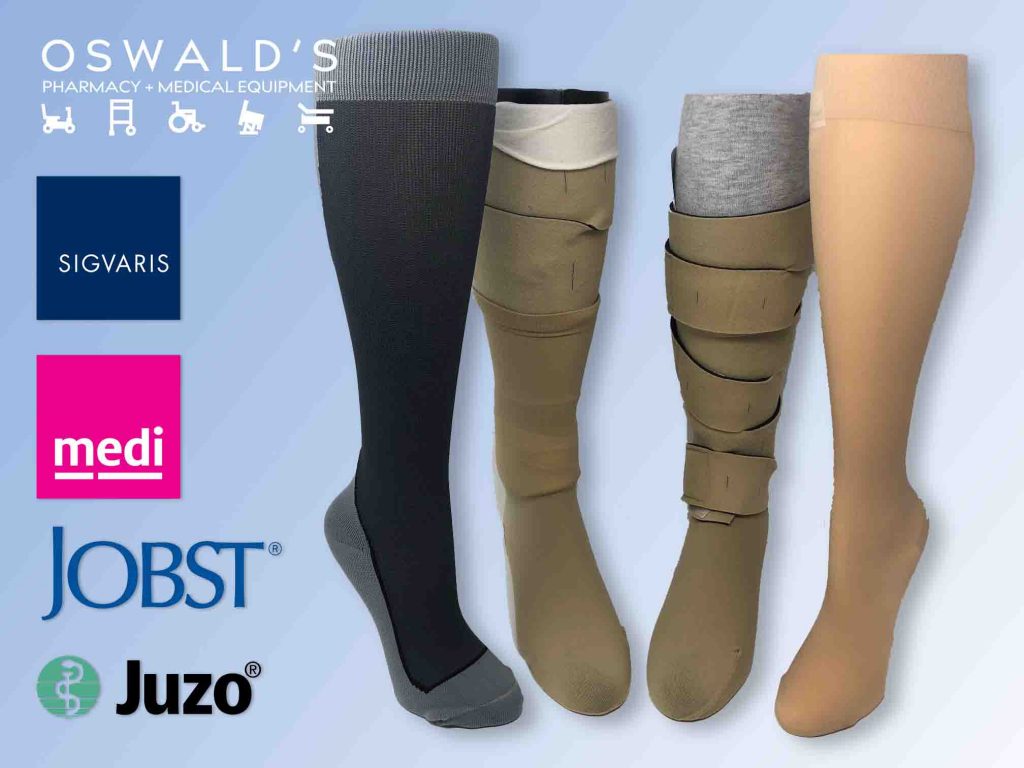Medical compression therapy is a field where you really ‘get what you pay for.’ Compression stockings are essentially a medication you wear instead of ingesting. Think of each pair of compression socks as a 6-month prescription supply.
To take the prescription analogy even further, think of compression strength as dosage strength in oral medications. Just as some medications come in 5mg, 10mg and 15mg strengths, compression hosiery comes in 8-15mmhg, 15-20mmhg, 20-30mmhg, 30-40mmhg and others.
More compression in a garment means more materials and a longer manufacturing time. This means that a pair of waist-high maternity hose will cost a good deal more than a pair of socks.
Think Of Compression As A Prescription
When you are given a prescription by your doctor for compression socks, the strength the doctor recommends should be taken very seriously. Your doctor has evaluated your condition and prescribed a compression strength that is just right. Certainly, doctors write actual compression prescriptions for a reason, right?
Just like ‘regular’ medications, compression hosiery can have side effects if you have the wrong strength. Circulation issues, joint pain, calluses and corns, numbness, skin irritation, and muscle spasms are some of the more common ones. Likewise, wearing stockings that are too tight or too loose can be downright uncomfortable as well.
Quality Manufacturing
Currently, the FDA does not require regulated testing of compression garments. In Europe, however, testing is required and only companies that comply with stringent standards can be sold. The quality gap between unregulated American compression garments and regulated European ones is vast.
The system currently used to evaluate compression garments in Europe originated in Germany. RAL on compression garments stands for the RAL Institute Quality Mark and Seal. (You might have to use Google translate for that page. It is based in Germany)
Some of the important things needed for an RAL seal:
- Elasticity and compression consistency
- Consistent pressure decrease (compression decrease from ankle to pressure gradient)
- Accepted yarns, materials, and fabrics allowed in certified compression garments
- Consistent sizes
- Appropriate product instructions and quality assurance policies for certified products
The compression we stock for everyday purchase is all manufactured by companies that conform to RAL quality standards. Everything from the materials to the longevity of the compression garments we sell is tested.
Help From Certified Compression Fitters
On top of selling compression products made by quality manufacturers, we have several certified compression fitters on staff. Our staff will make sure that your compression garment fits just like the doctor ordered.
We keep records of every customer’s measurements and purchases. If you think you need to be remeasured at any time, we can compare new measurements to the old and make recommendations based on this.
Our certified fitters will also go over the best donning practices with every customer. Donning is a fancy way of saying ‘putting on.’ Older customers or people with certain conditions can have a lot of trouble putting compression hosiery on. Any customer with donning questions or concerns can talk to one of our compression experts before they leave the store.
If you need assistance with putting your stockings on, we have several donning devices that help with different problems. The certified fitters on staff will find something to help you, no matter the issue.
Take Compression Therapy Seriously
There are several price points available on most of our stockings, so we can accommodate those who have concerns over the cost.
Compression garments are a fantastic tool to deal with many conditions. The fact that doctors regularly prescribe compression should make us stop and think for a minute; “Maybe I should treat this like any other prescription my doctor would give me.” If you want to be sure you get what your doctor wants you to have, spending a couple dollars more for stockings made by a certified manufacturer should be the least of your concern.
A Few Warnings
- If you see brand name stockings ‘on sale’ online at a price that is too good to be true, it is! All of the brands we stock have minimum allowed prices—if a price is advertised lower than what we sell them for that vendor is NOT buying from the manufacturer. These ‘deals’ are usually for out of date stockings, which means the elasticity of the socks may be compromised!
- Minimum advertised prices exist for a very good reason. Customers need to be educated on the products they purchase. It is hard to get quick and accurate product information when making a purchase online. Purchasing the wrong product costs everyone involved (manufacturer-vendor-customer). How much time does everyone save when the initial purchase is the last (and best) one? It can be very difficult to find specifics on the internet, as good as YouTube is.
- If you are looking on Amazon or Walmart, beware of any ‘FDA approved’ messages related to stockings. First of all, the FDA does not approve stockings. Secondly, FDA approval could relate to any aspect of a vendor’s business. Usually, this type of FDA approval just means that their facility has been approved by the FDA.
Setup Time to Talk to Our Expert
Article idea, structure, and key points were written by our Hosiery buyer and lead fitter, Ori. If you have any questions or want to schedule an appointment with Ori, don’t hesitate to give us a call! She is here most weekdays and loves it when customers set up a time to come in and chat.


